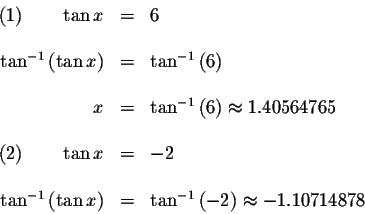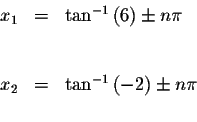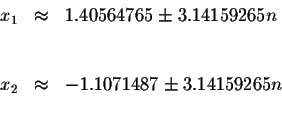 SOLVING TRIGONOMETRIC EQUATIONS
SOLVING TRIGONOMETRIC EQUATIONS SOLVING TRIGONOMETRIC EQUATIONS
SOLVING TRIGONOMETRIC EQUATIONS
Note: If you would like a review of trigonometry, click on trigonometry.
Example 3: Solve for x in the following equation.
There are an infinite number of solutions to this problem.
Isolate the tangent term. To do this rewrite the left side of the equation in an equivalent factored form.

The product of two factors equals zero if at least one of the factors equals
zeros. This means that
![]() if
if
![]() or
or
![]()
We have transformed a difficult problem into two problems. To find the
solutions to the original equation,
![]() ,
we find the solutions to the equations
,
we find the solutions to the equations
![]() and
and
![]()


How do we isolate the x? We could take the arctangent of both sides. However, the tangent function is not a one-to-one function.
Let's restrict the domain so that the function is one-to-one on the
restricted domain while preserving the original range. The graph of the
tangent function is one-to-one on the interval
 .
If we restrict the domain of the tangent function to that interval , we can take the arctangent of both sides of each equation.
.
If we restrict the domain of the tangent function to that interval , we can take the arctangent of both sides of each equation.

Since the period of tan x equals ![]() ,
these solutions will repeat every
,
these solutions will repeat every ![]() units. The exact solutions are
units. The exact solutions are

where n is an integer.
The approximate values of these solutions are

where n is an integer.
One can check each solution algebraically by substituting each solution in the original equation. If, after the substitution, the left side of the original equation equals the right side of the original equation, the solution is valid.
One can also check the solutions graphically by graphing the function formed by the left side of the original equation and graphing the function formed by the right side of the original equation. The x-coordinates of the points of intersection are the solutions. The right side of the equation is 0 and <tex2htmlcommentmark> f(x)=0 is the x-axis. So really what you are looking for are the x-intercepts to the function formed by the left side of the equation.
Algebraic Check:
Check solution
![]()
Left Side:
Right Side: 0
Since the left side of the original equation equals the right side of the original equation when you substitute 1.40564765 for x, then 1.40564765 is a solution.
Check solution
![]()
Left Side:
Right Side: 0
Since the left side of the original equation equals the right side of the original equation when you substitute -1.10714878 for x, then -1.10714878 is a solution.
We have just verified that
![]() and
and
![]() are the exact solutions and these solutions repeat
every
are the exact solutions and these solutions repeat
every ![]() units. The approximate values of these solutions are
units. The approximate values of these solutions are
![]() and
and
![]() and these solutions repeat every
and these solutions repeat every
![]() units.
units.
Graphical Check:
Graph the equation
![]() Note that the graph crosses the x-axis many times indicating many solutions.
Note that the graph crosses the x-axis many times indicating many solutions.
The graph crosses the x-axis at
1.04564765. Since the period is
![]() ,
you can verify that the graph also crosses the x-axis again at
1.04564765+3.14159265=4.54724 and at
,
you can verify that the graph also crosses the x-axis again at
1.04564765+3.14159265=4.54724 and at
![]() ,
etc.
,
etc.
The graph crosses the x-axis at
-1.10714878. Since the period is
![]() ,
you can verify that the graph also crosses the x-axis again at
-1.10714878+3.14159265=2.0344439 and at
,
you can verify that the graph also crosses the x-axis again at
-1.10714878+3.14159265=2.0344439 and at
![]() ,
etc.
,
etc.
Note: If the problem were to find the solutions in the interval
![]() ,
then you choose those solutions from the set of infinite
solutions that belong to the set
,
then you choose those solutions from the set of infinite
solutions that belong to the set
![]()
![]()
If you would like to work another example, click on Example.
If you would like to test yourself by working some problems similar to this example, click on Problem.
If you would like to go to the next section, click on next.
If you would like to go back to the previous section, click on previous.
If you would like to go back to the equation table of contents, click on Contents.

